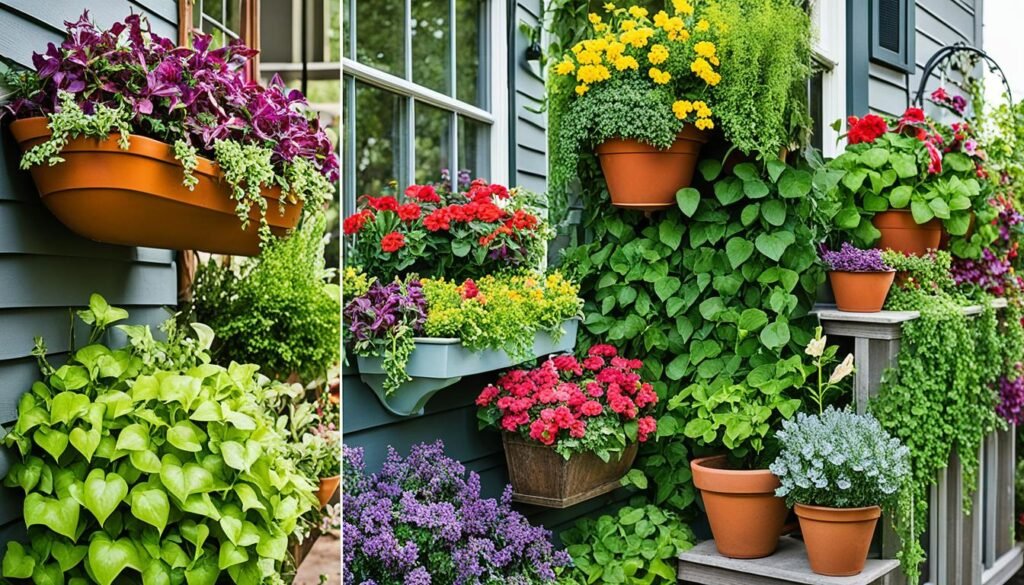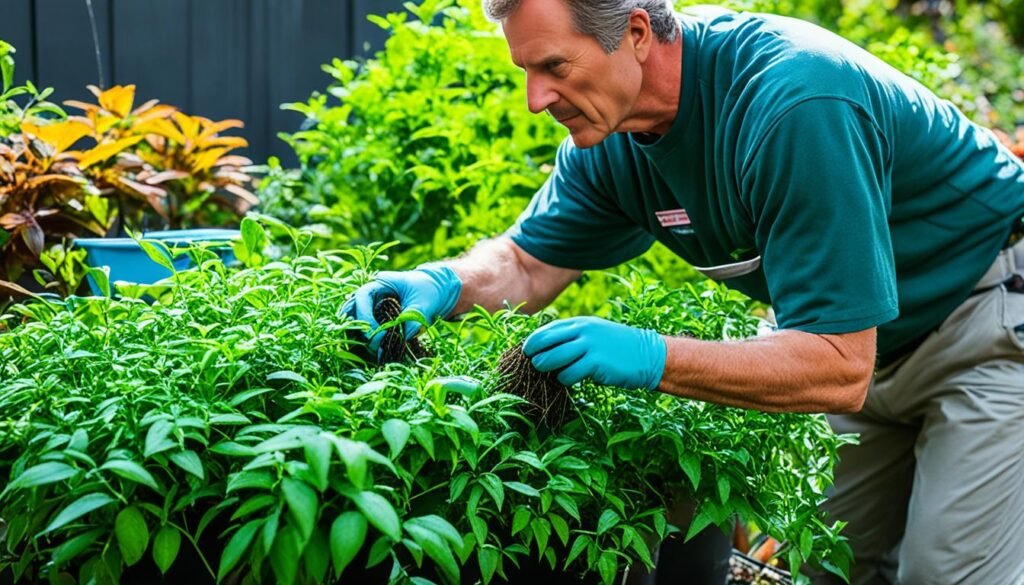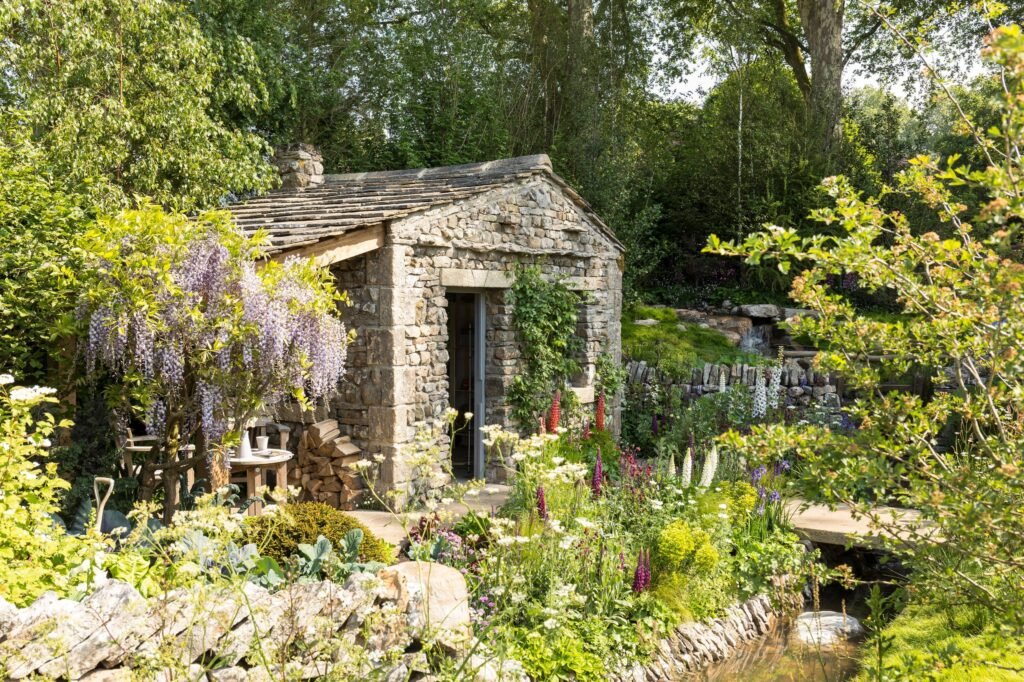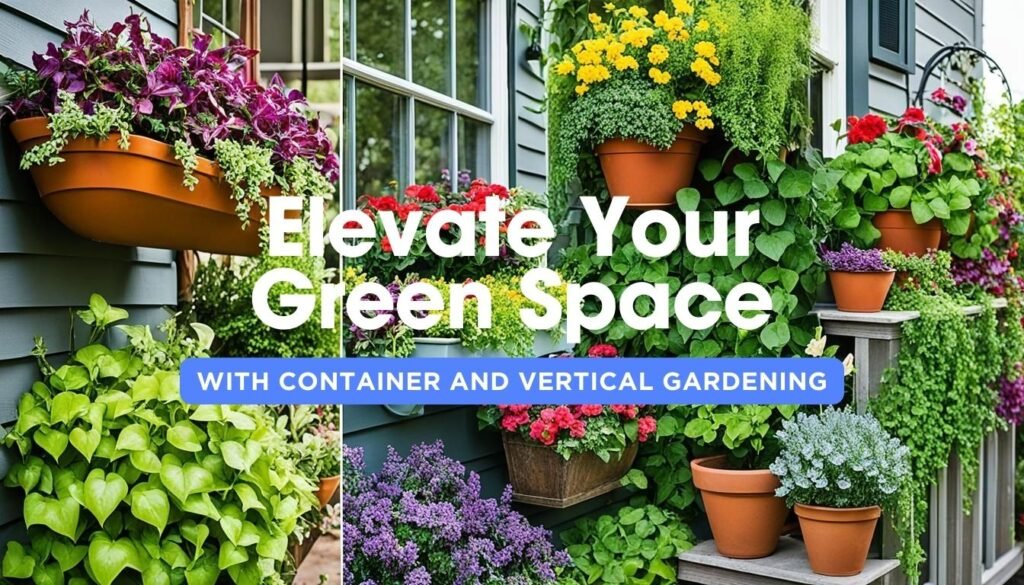
Did you know that urban gardening is on the rise, with more people embracing the beauty and benefits of growing plants in small spaces? In fact, according to a recent survey, over 60% of city dwellers in the United Kingdom are exploring container gardening and vertical gardening as innovative solutions to bring greenery into their urban environments.
Whether you have a tiny balcony, a rooftop, or limited floor space, container and vertical gardening techniques allow you to create lush and vibrant gardens that enhance your living space. In this article, I’ll guide you through the basics of container and vertical gardening, share tips for choosing the right plants, offer maintenance advice, and provide inspiring case studies to fuel your creativity.
The Basics of Container Gardening
Container gardening is a popular technique for growing plants in pots and other containers. It is especially suitable for small spaces like balconies and indoor areas. To start a container garden, you need to plan the layout, choose the right containers and soil, and select suitable plants. Container gardening offers versatility in terms of plant selection and arrangement, allowing you to customize your green space according to your preferences.
When planning the layout of your container garden, consider the available space and sunlight exposure. Determine how many containers you can accommodate and how they will be arranged to optimize plant growth. Choose containers that are appropriately sized for the plants you wish to grow, ensuring they have proper drainage to prevent overwatering.
Selecting the right containers is crucial for successful container gardening. Look for containers made of durable materials like terracotta, plastic, or fiberglass, as they provide insulation and retain moisture. Consider the style and aesthetic you want to achieve and choose containers that complement your space.
Next, choose the suitable potting soil for your container garden. Opt for a well-draining soil mix that retains moisture while allowing excess water to flow out. Avoid using garden soil alone, as it may become compacted and hinder root growth. You can find pre-mixed potting soils designed specifically for container gardening at your local garden center or nursery.
Now comes the exciting part: selecting the plants for your container garden. Consider the size and growth habit of the plants as well as their light and water requirements. Balcony gardening offers the opportunity to grow a variety of plants, from vibrant flowers and foliage plants to herbs and even small vegetables.
When selecting plants for indoor container gardening, consider the available light conditions in your home. Choose plants that thrive in low-light environments if your space doesn’t receive direct sunlight. Alternatively, if your indoor area has ample natural light, you can choose from a wider range of plants.
Now that you have the basics down, it’s time to get creative! Experiment with different plant combinations and arrangements to create a visually stunning container garden. Play with colors, textures, and heights to achieve a balanced and aesthetically pleasing display.
Remember, container gardening allows you to enjoy the beauty of nature even in limited spaces. With the right planning, careful selection of gardening containers, and suitable plants, you can transform your balcony or indoor area into a lush oasis. Let your imagination run wild, and watch your container garden thrive!
The Basics of Vertical Gardening
Vertical gardening is a space-efficient technique that involves growing plants vertically, utilizing walls, fences, or structures. It is ideal for small spaces and can be implemented both outdoors and indoors.
The key to successful vertical gardening lies in proper planning, plant selection, and maintenance. By going vertical, you can create stunning green walls, hanging gardens, and vertical structures that add beauty and functionality to your space.
When starting a vertical garden, consider the layout and available vertical surfaces. Look for sturdy structures or install trellises and supports for climbing plants. Choose plants that are suitable for vertical growth and have compact root systems.
Some popular plants for vertical gardening include ivy, ferns, herbs, and small flowering plants. These plants thrive in vertical environments and can create a lush and vibrant display.
Vertical gardening offers numerous benefits for small space gardening. It maximizes the use of limited space, allows for easy access to plants, and adds visual interest to walls or unused areas. Additionally, vertical gardens can help insulate buildings, control temperature, and improve air quality.
By implementing vertical gardening techniques, you can transform small balconies, rooftops, or empty walls into green havens. Let your creativity flourish as you design unique vertical gardens that bring life to your surroundings.
Elevate Your Garden with Vertical Structures
Vertical structures are a great addition to vertical gardens. They not only provide support for climbing plants but also add architectural interest to your space. Consider incorporating trellises, arches, or vertical planters to create a visually appealing and functional garden.
- Use trellises to train vining plants and create a vertical focal point.
- Add arches or pergolas for a dramatic entrance or pathway.
- Opt for vertical planters or pocket walls to maximize planting space.
- Combine different vertical structures to create a multi-dimensional garden.
With these vertical gardening techniques, you can turn any small space into a thriving green oasis.
Choosing Plants for Your Vertical and Container Gardens

Understanding Sunlight and Climate
It’s crucial to consider how much sunlight your garden area receives. For sunny spots, opt for sun-loving plants like petunias, marigolds, and cherry tomatoes, which thrive under direct light. For shaded areas, ferns, hostas, and mint can flourish, as they require less sunlight. This initial step ensures your garden starts on the right foot by matching plant preferences with available natural resources.
Consider Maintenance Levels
Evaluate how much time you can devote to caring for your garden. For those with a busy lifestyle, low-maintenance plants like succulents or snake plants are ideal, as they require minimal watering and care. On the other hand, if you have more time, consider nurturing herbs such as basil and parsley or vegetables like carrots and radishes, which need regular attention to prosper.
A Rich Tapestry of Plants
Flowering Plants for Visual Impact and Ecology
Incorporate a variety of flowering plants to add bursts of colour and attract beneficial pollinators to your garden. Consider bee-friendly plants like lavender and foxgloves, which are not only beautiful but also support local wildlife. Other great options include nasturtiums and sunflowers, which bring vibrancy and height to your space.
Foliage Plants for Depth and Texture
Foliage plants are essential for creating a verdant backdrop and adding texture to your garden. Options like silver dust or coleus offer intriguing leaf patterns and colours. Climbing plants such as ivy or Virginia creeper can be trained up trellises to utilize vertical space effectively, providing lush green screens.
Edibles for Sustainability and Enjoyment
Mixing in edible plants delivers the joy of harvesting your own food. Compact vegetables such as lettuce, peppers, and dwarf beans are perfect for container gardening. Strawberry plants and climbing peas can make excellent use of vertical growing spaces. Herbs like chives, rosemary, and mint are not only culinary delights but also easy to grow and manage in small spaces.
Creative Container and Vertical Techniques
Exploiting Vertical Surfaces
Use vertical structures like trellises or growing walls for climbing plants such as jasmine or runner beans, which add height and create living green walls. This approach maximises the growing area and adds a striking visual element to your garden.
Innovative Use of Hanging Baskets
Hanging baskets can be a fantastic way to display trailing plants like lobelia, fuchsia, or trailing tomatoes, which cascade over the sides creating a stunning display. They are also perfect for utilising overhead space, keeping the ground area less cluttered.
By carefully selecting plants that suit your garden’s specific conditions and your personal maintenance capacity, you can create a thriving, diverse, and visually appealing outdoor space. From ornamental blooms to practical vegetable plots, each choice you make enriches your garden, enhancing both its aesthetics and productivity. This thoughtful approach not only beautifies your home but also contributes to a sustainable urban environment.
Maintenance Tips for Container and Vertical Gardens

Regular maintenance is essential for the health and longevity of container and vertical gardens. As a gardener, keeping up with maintenance tasks ensures that your plants thrive and continue to bring joy to your space.
Watering
Proper watering is crucial for the well-being of your plants. Pay attention to the moisture levels in the soil and adjust the frequency of watering based on the specific needs of each plant. Be careful not to overwater, as it can lead to root rot and other water-related issues. It’s recommended to water your container and vertical gardens thoroughly, allowing the soil to drain completely to prevent waterlogging.
Fertilizing
Giving your plants the necessary nutrients through regular fertilization promotes healthy growth and vibrant blooms. Utilize organic fertilizers suitable for container and vertical gardening, following the product instructions for application rates and timings. Keep in mind that different plants have varying fertilization needs, so adjust your fertilizing schedule accordingly.
Pruning
Pruning helps maintain the shape, size, and overall health of your plants. Regularly inspect your container and vertical gardens for damaged or dead branches and remove them to prevent the spread of diseases. Additionally, trim back any excessive growth to encourage bushier and more compact plants. Pruning should be done with clean and sharp tools, making clean cuts just above a growth node.
Pest Control
Pests can pose a threat to the well-being of your container and vertical gardens. Stay vigilant and regularly inspect your plants for signs of pests like aphids, snails, or spider mites. Consider natural pest control methods, such as introducing beneficial insects or using organic insecticides. Early detection and prompt action can help prevent pest infestations from spreading and damaging your garden.
Seasonal Adjustments
Adjusting your maintenance routine based on seasonal changes is crucial for the success of your container and vertical gardens. As the weather shifts, pay attention to temperature fluctuations, light exposure, and moisture levels. During the colder months, protect your plants from frost by covering them with protective materials. In the warmer months, provide adequate hydration and consider providing shade for sun-sensitive plants. Adapting your gardening techniques to each season ensures that your plants thrive and flourish all year round.
Remember: proper maintenance, seasonal adjustments, and gardening techniques are key to the success of your container and vertical gardens. By implementing these tips, you’ll create a thriving green space that brings beauty and tranquility right to your doorstep.
Seasonal Adjustments for Container and Vertical Gardens

Container and vertical gardens require seasonal adjustments to ensure the optimal growth and health of your plants. By understanding the changing weather conditions and the specific needs of your green space, you can create a thriving garden all year round.
Protecting Your Plants in Colder Months
During the colder months, it’s important to protect your container and vertical gardens from frost. Consider covering your plants with frost cloth or moving them indoors to provide insulation. Keep an eye on weather forecasts and take necessary precautions to shield your plants from harsh conditions. Additionally, ensure proper drainage to prevent waterlogging, which can be detrimental to the health of your plants.
Hydration and Shade in Warmer Months
As the temperature rises, your plants will require proper hydration to stay healthy and vibrant. Regularly water your container and vertical gardens to keep the soil moist but not waterlogged. Consider using a mulch layer to retain moisture and reduce the frequency of watering. Additionally, for sun-sensitive plants, provide shade options such as installing shade cloths or positioning them in areas that receive partial sunlight. This will protect your plants from excessive heat and prevent scorching.
Maximizing Growth and Health
To ensure maximum growth and health throughout the year, adjust your plant selection and placement according to the seasons. Some plants thrive better in particular seasons, while others may require protection during certain times of the year. Research the specific needs of your chosen plants and plan your garden accordingly. By considering the seasonal adjustments, you can create a balanced and thriving green space that flourishes despite changing conditions.
Remember to regularly monitor your plants for any signs of stress, pests, or diseases. Promptly address any issues to prevent further damage. Adjusting your gardening techniques and practices based on the seasons will contribute to the overall success and longevity of your container and vertical gardens.
Case Studies of Successful Container and Vertical Gardens
Exploring real-life case studies of successful container and vertical gardens can provide invaluable inspiration and insights for enhancing your own green space. These examples demonstrate how gardeners have creatively used limited space, arranged plants in unique ways, and implemented effective maintenance strategies. By learning from the experiences of others, you can adopt similar approaches to improve your own gardening projects. These case studies not only offer practical guidance but also highlight the inherent beauty and vast potential of these innovative gardening techniques.
Urban Courtyard Transformation

A notable example is the work of Mark Gregory, a renowned garden designer who created a lush urban courtyard for the RHS Chelsea Flower Show. Utilising vertical planters and green walls, Gregory maximised a compact area to showcase a vibrant array of perennial herbs, seasonal flowers, and compact shrubs. This installation demonstrates the effective use of vertical space in garden design, providing a lush, green retreat in urban settings. For more detailed insights, the RHS website offers extensive resources and articles on past Chelsea Flower Show projects. RHS Website
Kensington Roof Gardens: An Icon of Urban Green Space

The Kensington Roof Gardens, originally opened in 1938 on top of the former Derry & Toms building on Kensington High Street, London, is another exemplary case study. Covering 6,000 square metres, this expansive rooftop garden combined elements of container and vertical gardening within its design, featuring a diverse range of plants from traditional English garden flowers to fruit trees. Despite closing to the public in January 2018 due to lease issues, the gardens serve as a historic example of urban garden potential, showing how such spaces can contribute to biodiversity and local sustainability. More about its history and legacy can be explored on its Wikipedia page.
These case studies illustrate how container and vertical gardening can transform any green space, regardless of size or location. The unique plant arrangements and effective maintenance techniques highlighted in these examples showcase the endless possibilities of container and vertical gardening. Inspired by these success stories, you can start your own gardening journey, creating a beautiful green space that reflects your personal style and enhances your connection with nature.
Conclusion
Container and vertical gardening provide a multitude of opportunities for creating stunning and practical green spaces, even in the smallest areas. By making use of vertical space and carefully selecting your plants, you can transform your urban environment into a thriving oasis and experience the joys of gardening. Whether you have a balcony, rooftop, or indoor space, these innovative techniques offer a way to connect with nature and create a personal haven.
With container gardening, you have the freedom to customize your space, choosing from a wide variety of gardening containers to suit your style and needs. From balcony gardens to indoor plant arrangements, container gardening offers versatility and unlimited possibilities for green enthusiasts. Similarly, vertical gardening allows you to utilize vertical surfaces such as walls and fences, maximizing your space and creating visually stunning green walls and hanging gardens.
So, why wait? Start your container or vertical garden today and immerse yourself in the beauty and tranquility of nature. With the right plants, careful maintenance, and seasonal adjustments, your green space will flourish throughout the year, providing you with endless delight. Enjoy the journey of creating your own little paradise and elevate your urban environment with the wonders of container and vertical gardening.

